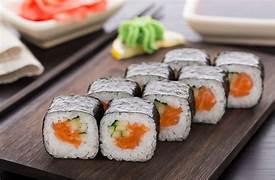Sushi, a beloved Japanese delicacy, has become a global sensation, celebrated for its exquisite taste, artistic presentation, and the meticulous craftsmanship that goes into each piece. Sushi rolls, in particular, showcase the versatility of this culinary art form. Let’s embark on a journey to discover the world of sushi and sushi rolls, from their origins to the modern-day creations.

Historical Roots:
Sushi can be traced back to ancient Japan, where it was initially a method of preserving fish by fermenting it with rice and salt. Over time, this preservation technique evolved, leading to various forms of sushi we know today.
Types of Sushi:
Nigiri Sushi:
Nigiri consists of bite-sized portions of vinegared rice topped with fresh seafood or other ingredients. It is often served with a dab of wasabi and a soy sauce dip.
Sashimi:
While not technically sushi, sashimi features thinly sliced raw fish, often served as an accompaniment to sushi.
Maki Sushi:
Maki rolls are a favorite among sushi enthusiasts. They consist of rice, seafood, vegetables, and other ingredients rolled in a sheet of nori (seaweed) and sliced into bite-sized pieces.
Temaki Sushi:
Temaki is a hand-rolled sushi cone filled with rice, seafood, and vegetables, designed to be eaten like an ice cream cone.
Popular Sushi Rolls:
California Roll:
A Western favorite, the California roll typically contains avocado, crab or imitation crab, cucumber, and sometimes fish roe.
Spicy Tuna Roll:
Featuring spicy tuna, cucumber, and sometimes avocado, this roll offers a delightful kick of heat.
Dragon Roll:
Known for its striking appearance, the dragon roll often contains eel, avocado, cucumber, and a layer of thinly sliced avocado on top, resembling dragon scales.
Rainbow Roll:
This colorful creation consists of a California roll topped with a variety of sashimi, creating a vibrant and flavorful medley.
Culinary Artistry:
Sushi is not just about taste but also visual aesthetics. Sushi chefs, known as “Itamae,” undergo rigorous training to perfect the art of slicing, rolling, and presenting each piece. The precise knife work and artistic arrangement of ingredients elevate sushi to an art form.
Dining Experience:
Sushi dining is a sensory experience. It involves choosing from an array of sushi and rolls, savoring the delicate flavors, and engaging in the interactive process of dipping in soy sauce, adding wasabi, and enjoying pickled ginger as a palate cleanser.
Cultural Significance:
Sushi has deep cultural roots in Japan and is often associated with special occasions and celebrations. It represents a harmonious balance of flavors, textures, and aesthetics.
Conclusion:
Sushi and sushi rolls are a testament to the culinary artistry of Japan, celebrated worldwide for their fresh ingredients, precision, and aesthetic appeal. Beyond the delightful taste, they offer a cultural journey and a glimpse into the meticulous craftsmanship that continues to shape the world of gastronomy.
